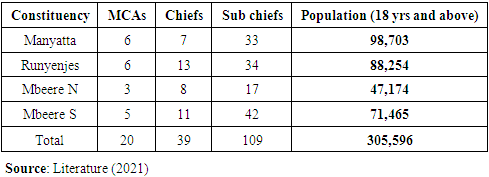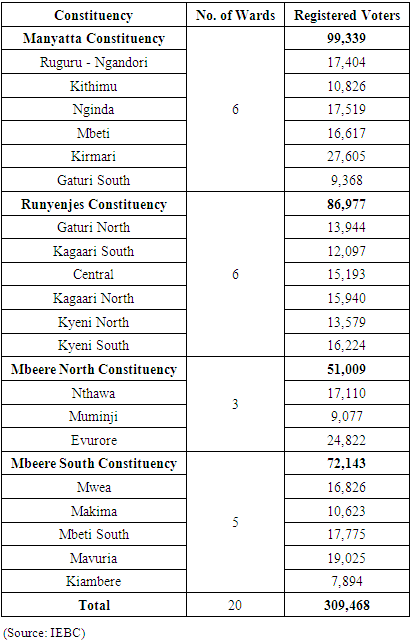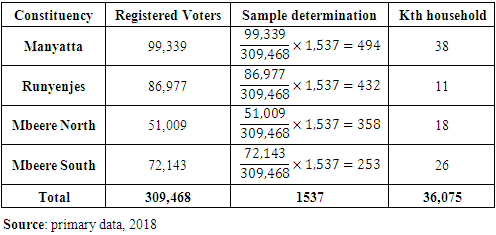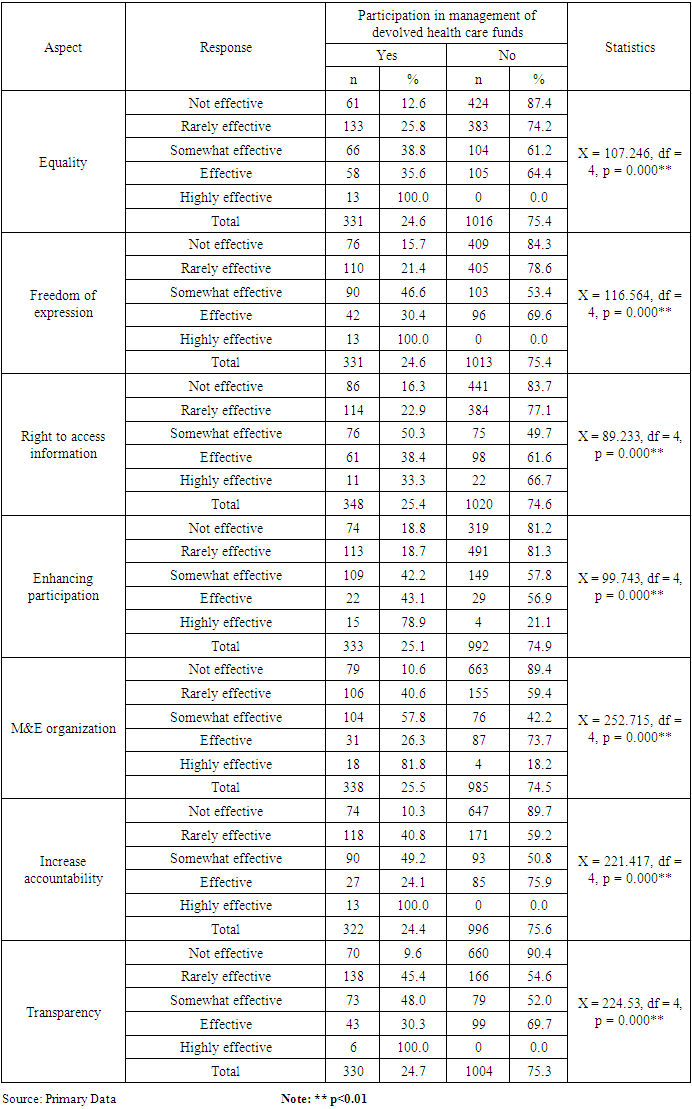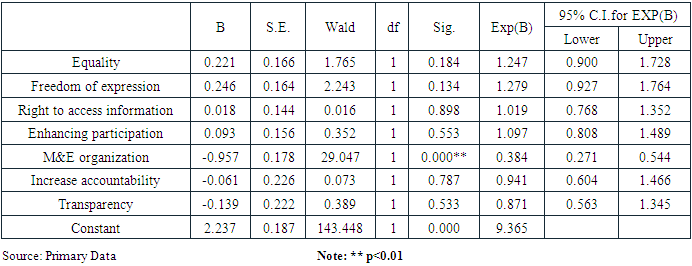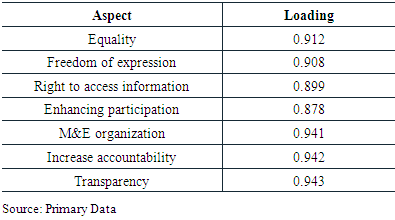-
Paper Information
- Paper Submission
-
Journal Information
- About This Journal
- Editorial Board
- Current Issue
- Archive
- Author Guidelines
- Contact Us
Public Health Research
p-ISSN: 2167-7263 e-ISSN: 2167-7247
2022; 12(4): 83-89
doi:10.5923/j.phr.20221204.01
Received: Aug. 21, 2022; Accepted: Sep. 10, 2022; Published: Sep. 23, 2022

Effectiveness of Current Legal and Institutional Frameworks Enabling Citizen Participation in the Management of Devolved Health Care Funds in Kenya
Kabeu Emma Watetu, Andre Yitambe, George Otieno
Department of Health Management and Informatics, Kenyatta University, Kenya
Correspondence to: Kabeu Emma Watetu, Department of Health Management and Informatics, Kenyatta University, Kenya.
| Email: |  |
Copyright © 2022 The Author(s). Published by Scientific & Academic Publishing.
This work is licensed under the Creative Commons Attribution International License (CC BY).
http://creativecommons.org/licenses/by/4.0/

Kenya, driven by the need to bring health care services closer to people has put in place laws and institutional frameworks to enable citizen participation in management of healthcare funds in the devolved units. The objective of this study was to investigate effectiveness of current legal and institutional frameworks enabling citizen participation in the management of devolved Health Care funds in Kenya. This study was carried out in Embu County where cross sectional descriptive design and mixed research design were used. The sample comprised of 20 Members of County Assemblies, 39 chiefs, 109 sub chiefs and 1,537 voters drawn from a population of309,468 community members aged 18 years and above. Data analysis was done using descriptive statistics, correlation and regression analysis. The study drew a response rate of 91.3%. The average age of the respondents was 41.44 (SD ± 15.83) and having lived in Embu county an average of 40.22 years. The study investigated 15 legal and institutional frameworks where effectiveness of all the aspects looked at was rated below 20% while Community’s level of awareness was less than 30%. On their effectiveness, these frameworks were only found to be statistically significant in Monitoring and evaluation (p<0.01; OR=0.384). The study concluded that current legal and institutional frameworks were barely effective, and awareness thereof was low. Therefore, the study recommended that both County and national governments should organize civic education to create awareness on, and enforce current existing legal and institutional frameworks that govern management of county healthcare funds to make them effective.
Keywords: Devolved, Legal and institutional frameworks, Citizen participation, Effectiveness
Cite this paper: Kabeu Emma Watetu, Andre Yitambe, George Otieno, Effectiveness of Current Legal and Institutional Frameworks Enabling Citizen Participation in the Management of Devolved Health Care Funds in Kenya, Public Health Research, Vol. 12 No. 4, 2022, pp. 83-89. doi: 10.5923/j.phr.20221204.01.
Article Outline
1. Introduction
- Devolution of health care, being itself a type of decentralization, is meant to change from central governance of the health system by allowing smaller administrative units design innovative models and interventions that suits their unique health care needs. This would in turn improve performance of the health systems (Okech 2017). This is because smaller organizations, if properly structured and led, are more agile and accountable than are larger organizations (Omondi 2019) Devolution is defined as a process of transfer of political, administrative and fiscal management powers between central government and lower levels of government, whereby in Kenyan context the former are 47 elected county governments Devolution of health care falls in Governance and leadership, which is a key pillar of health systems management (Okungu, 2019). Chapter eleven of the constitution of Kenya (2010) on devolution stipulates the requirement for the transfer and distribution of some state functions to smaller, semi-autonomous units of government – the counties. The constitution of Kenya also characterizes a strong and enforceable bill of rights that has encouraged citizens to hold the government accountable though participation. Financing of devolved health care is currently through budgetary allocation, through grants or donation from development partners/ charitable entities, through money raised by counties through taxes and licenses, and through loans. The counties have power to approach donors for funding. Due to the proximity of local governments to their communities, they are likely to be more transparent than national governments. The Kenya Health Policy 2012 – 2030 has outlined governance objectives under the new devolved outfit with emphasis on citizen participation and accountability in health service delivery, administration and management.
2. Objective of the Study
- The objective was to ascertain the effectiveness of current legal and institutional frameworks enabling citizen participation in the management of devolved Health Care funds in Embu County, Kenya.The frameworks namely Constitution of Kenya, articles 1(2); 10(2); 29; 33; 35; 174; 184; 232(1) (d); Fourth Schedule part 2(14); The Public Finance Management Act section 91; County Governments Act sections 91; 94; 95; 96, 100; 101; Public Procurement and Disposal Act 2015 section 68 (3); 126(5); 138; 179 were tested for their effectiveness in enhancing Equality; Freedom of expression; right to access information; Enhancing; participation; M&E organization; increase accountability and transparency.
3. Materials and Methods
- This study employed cross sectional descriptive research design approach. In addition, the study adopted a mixed research design. It was conducted in Embu County where study population was the community members and leaders. All constituencies (4) within the Embu County were sampled. The population of this study was 20 MCAs, 39 chiefs, 109 sub chiefs and 305,596 community members aged 18 years and above.
|
 where;nh is the sample size for stratum h, Nh is the stratum h population size, N is total population size, and n is total sample size.Purposive sampling was used to select staff working the Ministry of Health in the county, chiefs, MCAs and sub chiefs for qualitative data. Purposive sampling was also used to select County Health Committees for FGDs. Since the population of the MCAs (20), chiefs (39) and sub chiefs (109) is small a census approach was used. For community members, the following formula by Fisher et al., (1998) was used to calculate the sample size:
where;nh is the sample size for stratum h, Nh is the stratum h population size, N is total population size, and n is total sample size.Purposive sampling was used to select staff working the Ministry of Health in the county, chiefs, MCAs and sub chiefs for qualitative data. Purposive sampling was also used to select County Health Committees for FGDs. Since the population of the MCAs (20), chiefs (39) and sub chiefs (109) is small a census approach was used. For community members, the following formula by Fisher et al., (1998) was used to calculate the sample size:  Where: n = Desired sample size (when population is more than 10,000) Z = The standard normal deviate, usually set at 1.96, which corresponds to the 95% confidence level (normal curve)p = Sample proportion in the target population assumed to be participating in management of healthcare funds in Embu is 50% (0.5).q = 1-pD = Design effect = 4 (four constituencies (within one clusters) participating in the study)d = Degree of accuracyThe sample size is calculated as follows:Z =1.96; P = 0.5; q = 1-P; D = 4; d = 0.05
Where: n = Desired sample size (when population is more than 10,000) Z = The standard normal deviate, usually set at 1.96, which corresponds to the 95% confidence level (normal curve)p = Sample proportion in the target population assumed to be participating in management of healthcare funds in Embu is 50% (0.5).q = 1-pD = Design effect = 4 (four constituencies (within one clusters) participating in the study)d = Degree of accuracyThe sample size is calculated as follows:Z =1.96; P = 0.5; q = 1-P; D = 4; d = 0.05 n = 1537 (voters)
n = 1537 (voters)
|
|
4. Results
- Socio- Demographic Economic Characteristics of RespondentsA total of 1403 respondents took part in the study. Most of the respondents sampled were within the youth bracket. Males were also slightly more than females. All elected MCAs were male, so consequently 100% of the interviewed MCAs were male. At constituency level, Manyatta constituency had the most respondents while Mbeere South contituency had the least. Majority of the respondents were married (54.7%). The widowed were 16.85%, single 15.1%, separated 7.5% and divorced 5.8%. In terms of occupation the respondents were almost evenly distributed among casual laborers, self-employed/business and farming (24.9%, 24.1%, 23.3%). Those who considered themselves employed full time were 14.9% while the unemployed were 12.8%. Only 5.1% lacked formal education. Over 70% had attained secondary education and above.Community’s level of awareness on legal, policy and institutional frameworksLevel of awareness on legal, policy and institutional frameworks among respondents was wanting as all the frameworks investigated had over 70% of the respondents not being aware. County Government Act Sections 100 and 101 had a slight higher level of awareness 26.1% and he least Constitution of Kenya 2010 Article 174(d). Those interviewed at county offices had some awareness. A FDG discussant said “civic education has not been sufficient. At times we don’t think it concerns us”. Another discussant said ”hii katiba hata ukisoma hauwezi elewa, na hawataki tuelewe sana (the constituition (jargon) is hard to understand; they (government) doesn’t want us to understand it)
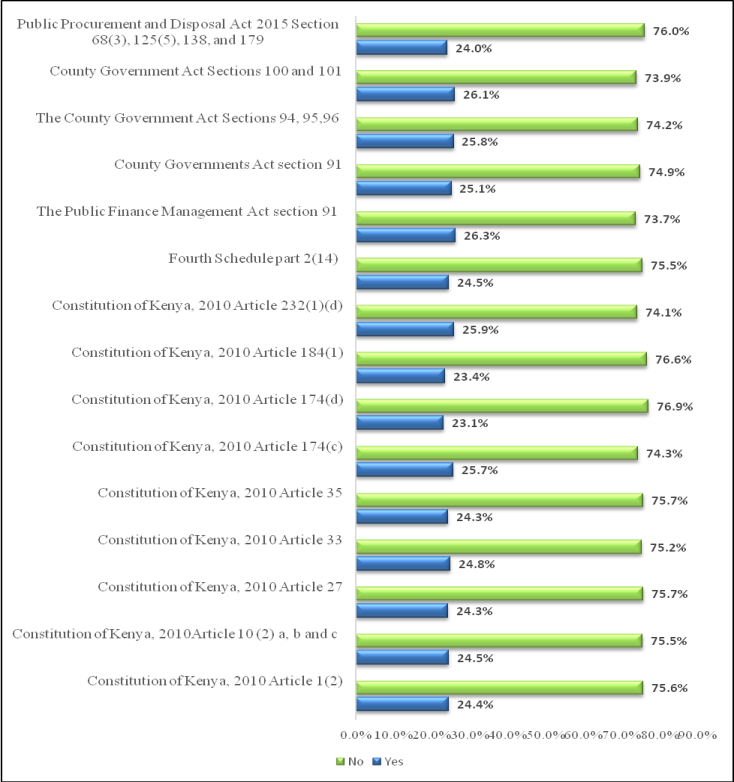 | Figure 4.1. Community’s level of awareness on legal, policy and institutional frameworks (Source: Primary Data) |
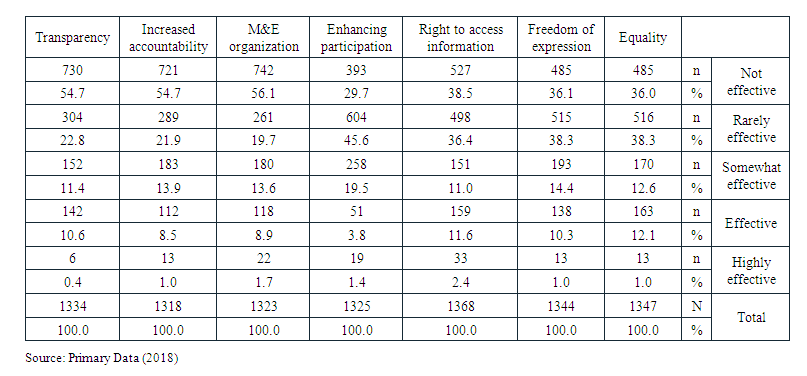 | Table 4.1. Rating effectiveness of current legal and institutional frameworks |
|
|
|
5. Conclusions
- The study concluded that there was low awareness of current legal and institutional frameworks. Therefore, they were barely effective in as far as management of devolved funds in Embu County was concerned. The legal and institution frameworks were least rated on their effectiveness in increasing accountability.
6. Recommendations
- The study recommended that, in as much as legal and institutional frameworks governing management of devolved healthcare funds exist, the national and county governments should do more to enforce them.
 Abstract
Abstract Reference
Reference Full-Text PDF
Full-Text PDF Full-text HTML
Full-text HTML